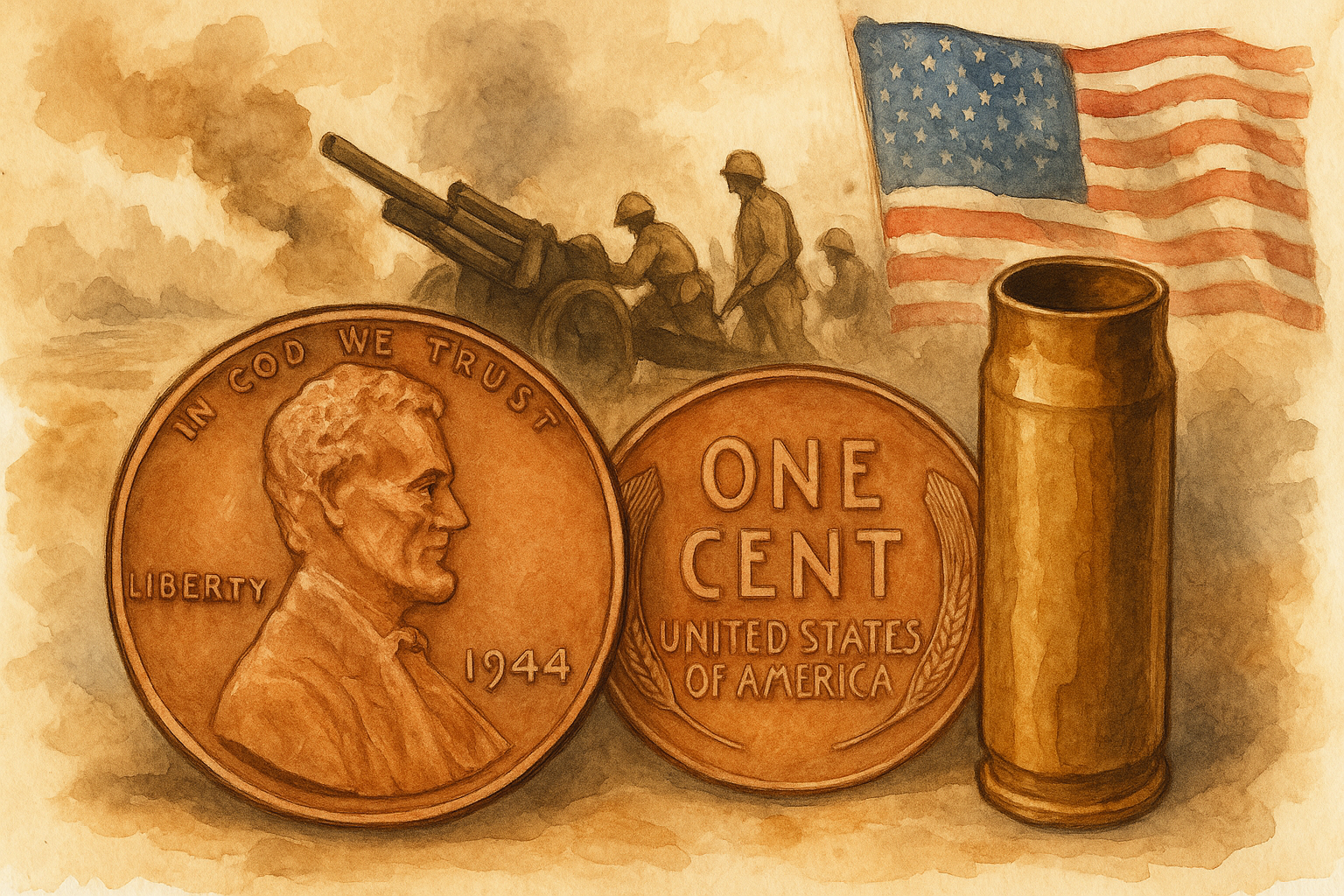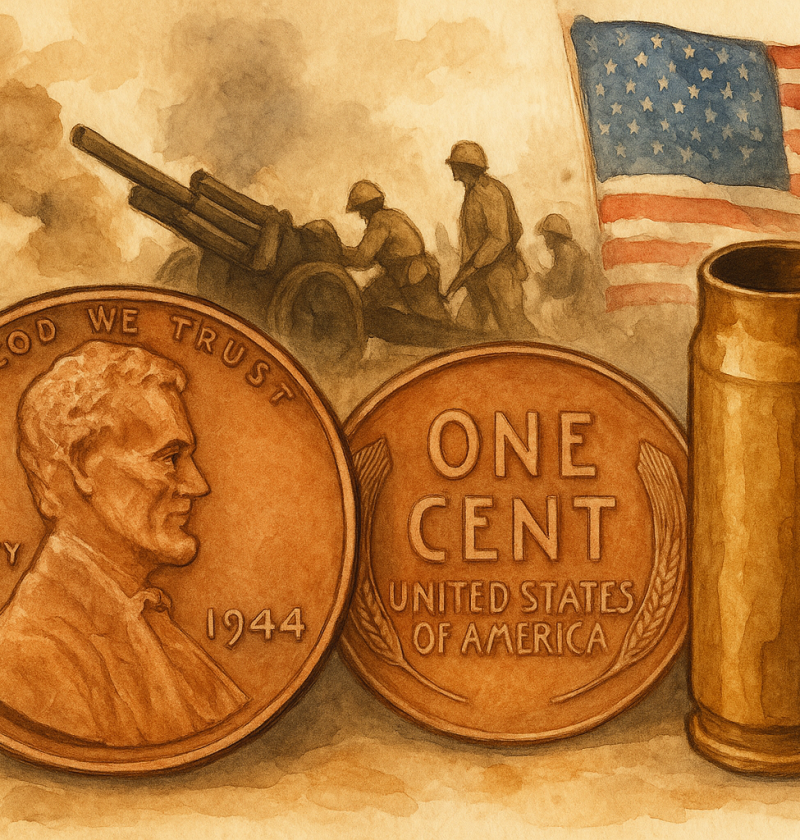Coins may seem like simple metal disks, but they’re time capsules—each one minted with decisions shaped by wars, policies, and human ingenuity. One of the most intriguing examples?
The 1944 penny. This unassuming coin tells a powerful story of innovation under pressure and post-war transition. More than just a monetary unit, it’s a relic of national resilience and resourcefulness.
Let’s take a look at how one penny became an enduring symbol of American history and remains a favorite among numismatists today.

Wartime Necessity Brings Change
By 1943, the U.S. was neck-deep in World War II. Copper, critical for military equipment and ammunition, was suddenly too valuable for pennies. As a response, the U.S. Mint temporarily shifted to zinc-coated steel planchets.
These “steel cents” were cost-effective and conserved copper, but they had significant drawbacks: they rusted quickly, they jammed vending machines, and their silver-like color made them easily mistaken for dimes.
Realizing the public’s dissatisfaction, the Mint adjusted again in 1944. But instead of tapping into fresh copper reserves, they sourced the metal from recycled military shell casings. This was not only practical—it was symbolic. These “shell case cents” carried the memory of spent ammunition and the promise of peace.
Unique Alloy: Shell Case Brass
What sets the 1944 penny apart chemically is its composition. While pre-war coins used a bronze alloy (typically 95% copper and 5% tin and zinc), the 1944 edition was struck in brass—a mix of 95% copper and 5% zinc.
The source? Salvaged artillery shell casings from the battlefield. This subtle change in alloy gave the coins a slightly lighter color and imbued them with a unique wartime character.
It’s rare that coins offer a direct material link to a specific historical event. But the 1944 penny does just that—casting a bridge between the home front and the global battlefield in the form of small, circulating artifacts.
Iconic Design and Production Features
While the composition changed, the design of the 1944 penny retained its iconic elements:
| Feature | Detail |
| Obverse | Abraham Lincoln portrait by Victor D. Brenner |
| Reverse | Two wheat stalks, giving rise to the name “Wheat Penny” |
| Metal | 95% copper, 5% zinc (brass); rare error coins struck in steel |
| Diameter | 19.05 mm |
| Weight | 3.11g for copper, 2.70g for steel errors |
| Edge | Plain |
| Mintmarks | No mark (Philadelphia), D (Denver), S (San Francisco) |
Most 1944 pennies were minted in Philadelphia (no mintmark), but Denver and San Francisco also produced large quantities. While the design stayed consistent, the story behind the metal changed entirely.
From Circulation to Collection
At the time of their release, these coins were nothing more than pocket change. But today, the 1944 penny sits at the intersection of affordability and collectibility. They’re an accessible entry point for beginners—many still exist in circulation or in family coin jars—yet specific rarities and error versions command the attention of advanced collectors.
And here’s where the 1944 penny’s story gets even more compelling: Not every 1944 penny was made of brass. A few highly valuable exceptions escaped the Mint’s notice—struck not in brass, but mistakenly on steel planchets leftover from 1943. These rare variants fuel intense interest, making the 1944 penny one of the most dynamic coins in U.S. numismatic history.
1. A Historic Return to Copper—With a Wartime Twist
When the U.S. Mint resumed copper penny production in 1944, it wasn’t just about switching metals. It was a moment of symbolic transition—from war rationing to cautious normalization. But this wasn’t ordinary copper. The Mint repurposed shell casings collected from military training facilities and battlefields, forging each penny with echoes of American resilience.
These 1944 “shell case cents” weren’t only a solution to a supply problem—they were a statement of purpose. The government was turning instruments of war into instruments of economy. For collectors today, that narrative gives the coin weight far beyond its 3.11 grams.
2. The Legendary 1944 Steel Wheat Penny: Rarity Redefined
Among collectors, one of the most discussed—and hunted—U.S. cents is the 1944 steel penny. While steel planchets were officially retired after 1943, a small number of 1944 pennies were mistakenly struck using leftover steel blanks.
These “wrong planchet” errors are ultra-rare, with fewer than 50 verified examples across all three mint locations: Philadelphia, Denver, and San Francisco.
Notable Facts About the 1944 Steel Cent:
- Magnetic: Unlike the brass version, steel cents are attracted to magnets.
- Weight: ~2.70g (compared to 3.11g for brass).
- Value: Auction prices often exceed $100,000, with top-condition examples reaching over $400,000.
- Authentication Required: Because of high demand, many counterfeits exist (typically 1943 steel pennies altered to show a 1944 date or copper coins plated in zinc).
These steel errors are not only valuable—they’re legendary. They represent an anomaly that slipped past the quality checks of the U.S. Mint, now transforming them into six-figure trophies for serious numismatists.
3. Collector Value and Variations
The 1944 penny offers layers of collectibility. Whether you’re holding a standard brass coin or hoping to identify a valuable error, here’s how their worth breaks down:
1944 Penny Value Overview
| Mint Location | Type | Circulated (avg) | Uncirculated (MS-65+) | Rare Errors (Steel/Varieties) |
| Philadelphia | Brass (no mark) | $0.10 – $0.50 | $3 – $10 | $100,000+ (steel) |
| Denver (D) | Brass | $0.15 – $0.60 | $5 – $20 | $115,000+ (steel), D/S variety |
| San Francisco (S) | Brass | $0.20 – $0.75 | $8 – $30 | $125,000+ (steel), S/D variety |
Collectors also look for overmintmarks, where the Mint accidentally struck one mintmark over another (e.g., D over S). These hybrid errors are rare and can boost a coin’s value even if it’s not made of steel.
How to Know If You’ve Found a Rare One?
Owning a 1944 penny doesn’t automatically make you rich—but knowing what to look for might. Here’s a quick self-checklist:
Fast Identification Tips
- Magnet Test: If it sticks, it might be steel—and that’s your first clue toward rarity.
- Weigh It: Use a digital scale. If it weighs around 2.70g, you could have a steel version.
- Look Closely at Mintmarks: An “S” or “D” could signal a rarer variant. Use a magnifier to inspect for mintmark doubling or overstrikes.
- Surface Color: Brass cents appear red-brown to golden; steel ones are typically gray-blue unless plated.
If your coin raises any flags, the next step is to have it professionally authenticated and graded. Services like PCGS or NGC can determine if it’s genuine and assign a grade, which significantly influences value.

From Old Coins to Smart Tools
For decades, identifying and valuing coins like the 1944 penny required coin catalogs, expert advice, and often years of hands-on experience. Today, collectors—both novice and seasoned—can leverage AI-powered tools to streamline the process. Enter Coin ID Scanner, a game-changing app designed for modern numismatists.
Whether you’re rummaging through inherited coin jars or evaluating auction finds, this tool provides precise, on-demand insights to help distinguish common pennies from historical gems.
Key Features of Coin ID Scanner
| Feature | Description |
| Photo-Based Coin ID | Take or upload a photo of your 1944 penny. The app analyzes key attributes—design, mint year, metal type, edge, weight, and more. |
| Detailed Coin Profile | Access a complete data card: minting years, country, composition (brass or steel), known varieties, and approximate collector value. |
| Collection Management | Build and organize your personal digital coin album. Track each entry by grade, origin, and estimated worth. |
| Extensive Database | Includes data on over 187,000 global coins—from ancient to modern—with daily updates and historical references. |
| AI Coin Helper | Offers recommendations: is this penny rare? Should you grade it? What are similar auction prices? It’s like having a numismatist in your pocket. |
| Smart Filters (Premium) | Narrow your search by mintmark, alloy, condition, or known errors such as steel planchets and overmintmarks. |
This kind of functionality is especially valuable for detecting elusive varieties like the 1944 steel penny or high-grade San Francisco mint issues. It eliminates the guesswork and allows for instant learning, making the collecting experience more engaging and educational.
Why It Matters for 1944 Pennies
Coins like the 1944 penny come with nuances—same date, multiple mints, differing metals, and significant error potential. With tools like Coin ID Scanner:
- A magnet test can be supplemented by metal detection confirmation.
- You can weigh the coin and use the app to verify if it matches known weight thresholds.
- Suspected overmintmarks or die varieties can be matched against visual references in seconds.
- You gain immediate price estimates based on current market trends, not outdated catalogs.
The result? Smarter collecting, faster decision-making, and fewer missed opportunities.
A Timeless Coin Meets a New Era
The 1944 penny isn’t just a coin. It’s a physical echo of World War II, a wartime innovation, a mass-produced yet collectible object, and—on rare occasions—a valuable mistake. For collectors, its dual nature makes it thrilling: affordable and accessible for beginners, yet peppered with hidden gems worth thousands.
Apps like Coin ID Scanner make exploring this story easier than ever. With just a photo, you can unlock layers of history, identify variations, and even start building a curated digital collection.
Thanks to technology like Coin ID Scanner, the barrier to entry has never been lower, and the chance to learn—and profit—has never been higher. Whether you’re a hobbyist, history buff, or investor, don’t overlook this copper (or possibly steel) treasure. It just might be worth a second glance—and possibly, a small fortune.


